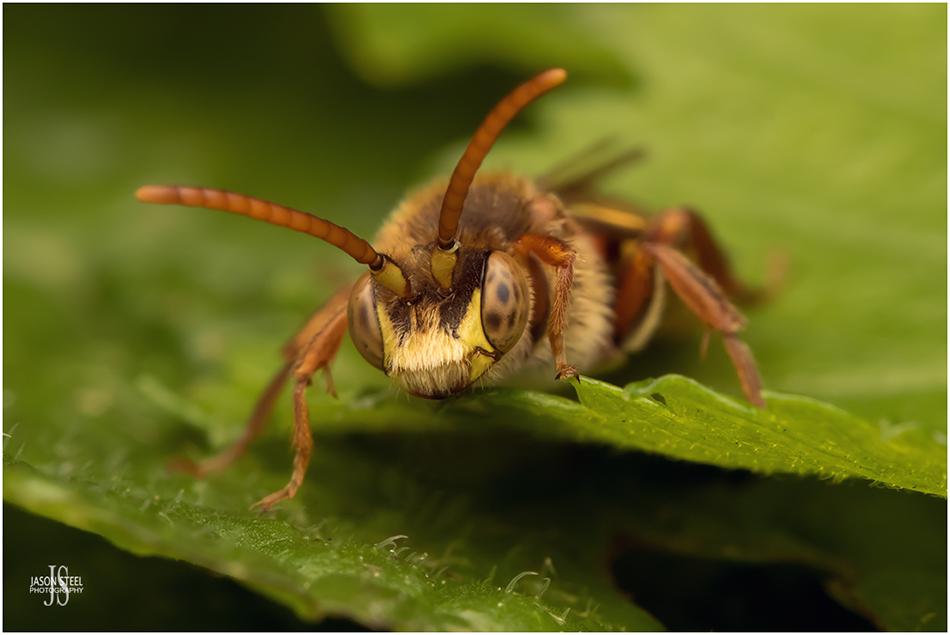
10mm male Nomad Bee, photographed in Lullingstone, Kent, 7th May 2023.
Nomad Bees - (Nomada sp.)
In the UK there are around 30 species of Nomad Bee. They are all very similar in appearance, and are mostly widespread in the southern half of England. The largest of these small slender bees have a body-length of around 10mm. With their narrow waist, striking markings, and hairless abdomen, these bees are very easily mistaken for wasps.
Nomad Bees, also known as Cuckoo Bees, are cleptoparasites. Adult Nomad Bees live solitary lives and feed on nectar. The adult female Nomad Bee lays her eggs in the nests of other Solitary Bee / Mining Bee species. The female Nomad Bee searches for the nests of the larger Andrena species of Mining Bee. Mining Bees build up stores of nectar and pollen in cells of their nests, intended as food supplies for their young to feed on. Once the nest is left unattended the Nomad Bee seizes the opportunity and enters the burrow of the Mining Bee and quickly lays her own egg in an unsealed nest cell. The grub of the Nomad Bee is equipped with large jaws and once hatched the grub wastes no time in using these jaws to kill the grubs and destroy the eggs of the Mining Bees, and begin feeding on the pollen and Nectar supplies built up by the Mining Bee intended for their own grubs. Whilst some Nomad Bees species target specific species of the Andrena Mining Bees, others will use the nests of any Mining Bees. Some will also target the nests of Blunthorn Bees, Melitta sp. too.
Most bees are covered with hairs which help collect pollen. They also have pollen collecting baskets on their hind legs. The abdomens of Nomad Bees though are almost completely hairless, and they are not equipped with pollen collecting baskets on their legs either. Nomad Bees are therefore unable to collect pollen themselves and are completely reliant of the food supplies collected by their hosts to feed their offspring. Both male and female Nomad Bees are completely harmless to humans and do not sting.
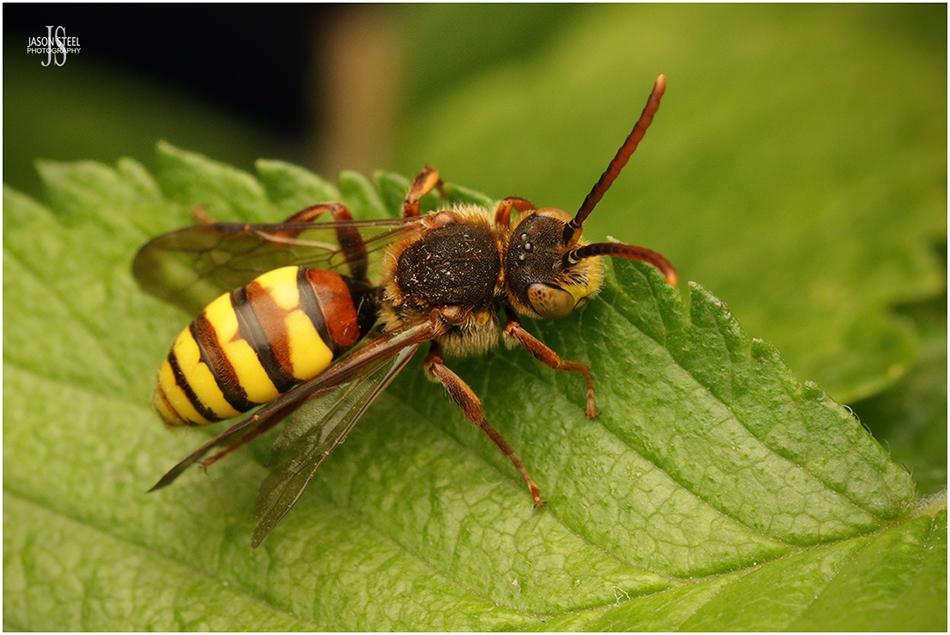
10mm male Nomad Bee, photographed in Lullingstone, Kent, 7th May 2023.
This Nomad Bee was one of several seen flying around the low branches of trees, at the sun-facing edges of large grass fields in Lullingstone, in north Kent at the start of May. The most common species of Nomad Bee is the Goodens Nomad Bee, Nomada goodeniana. Nomada goodeniana has black bands on its yellow abdomen though and not the black and reddish-brown bands seen on the specimen in these images. These bands indicate that this specimen is one of the Nomada flava group, which can be very difficult to distinguish even under a microscope. The Nomada flava group is comprised of the following species: Nomada flava, Nomada panzeri, Nomada ruficornis, Nomada glabella and Nomada signata.
From these photos the Nomad Bee seen here can be narrowed down to three species, Nomada flava, Nomada panzeri and Nomada ruficornis. Nomada flava and Nomada panzeri are almost impossible to distinguish. Nomada ruficornis can be identified by looking very closely at their bifid mandible tips. The mandible tips of Nomada ruficornis split into two points on each mandible, rather than just the one pointed tip that's seen on the mandibles of both the other species. Nomad Bees from this group fly from April to June.
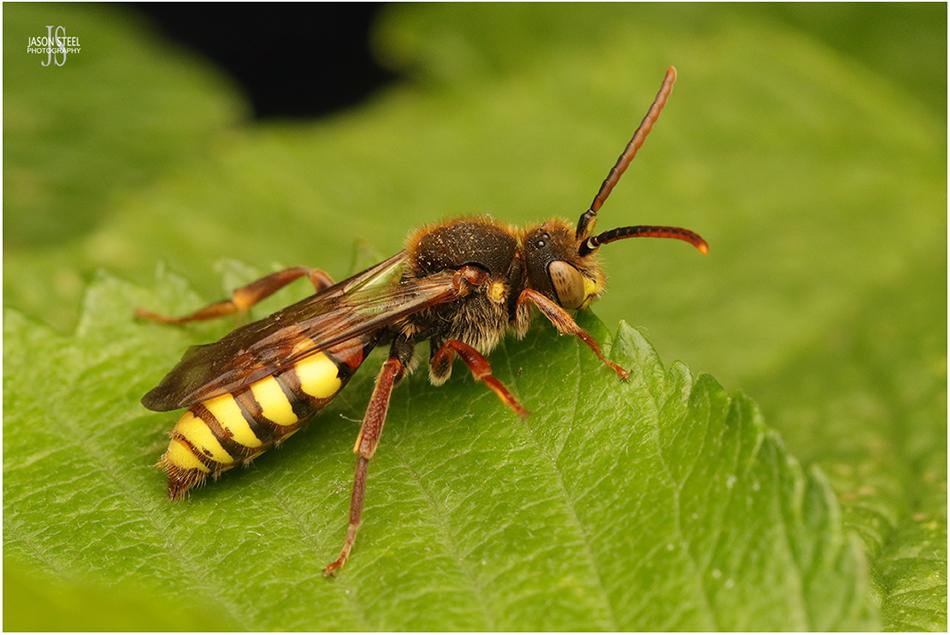
10mm male Nomad Bee, photographed in Lullingstone, Kent, 7th May 2023.
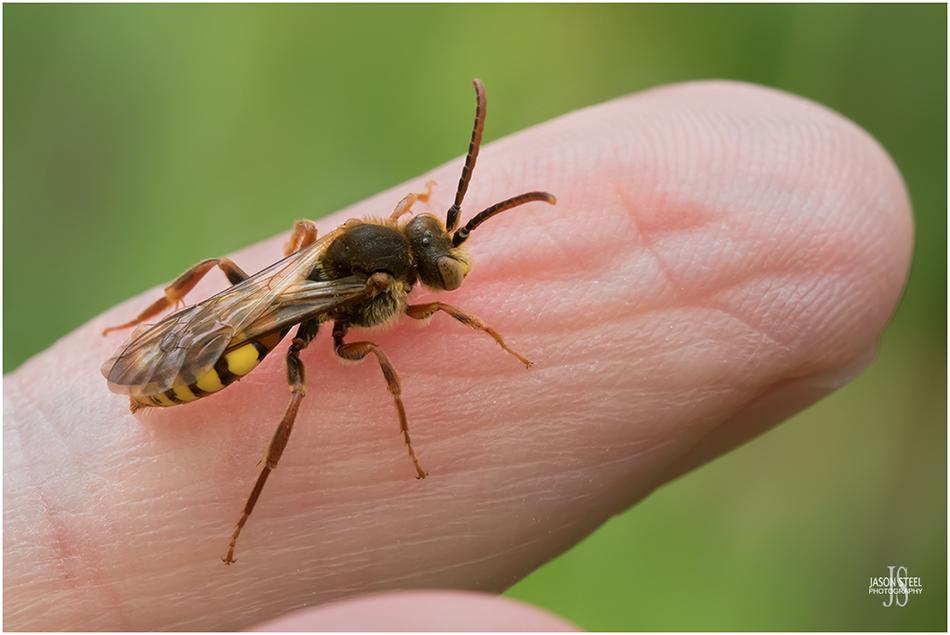
Harmless male Nomad Bee, photographed in Lullingstone, Kent, 7th May 2023.
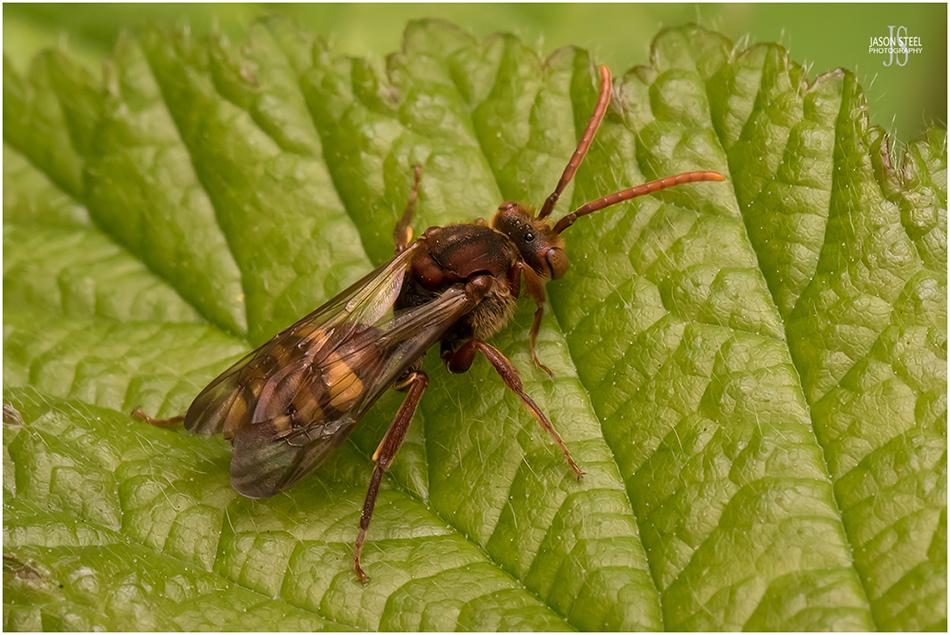
Another Nomad Bee species from the Nomada flava group, photographed at Regents Canal, in Camden, London 30th April 2023.
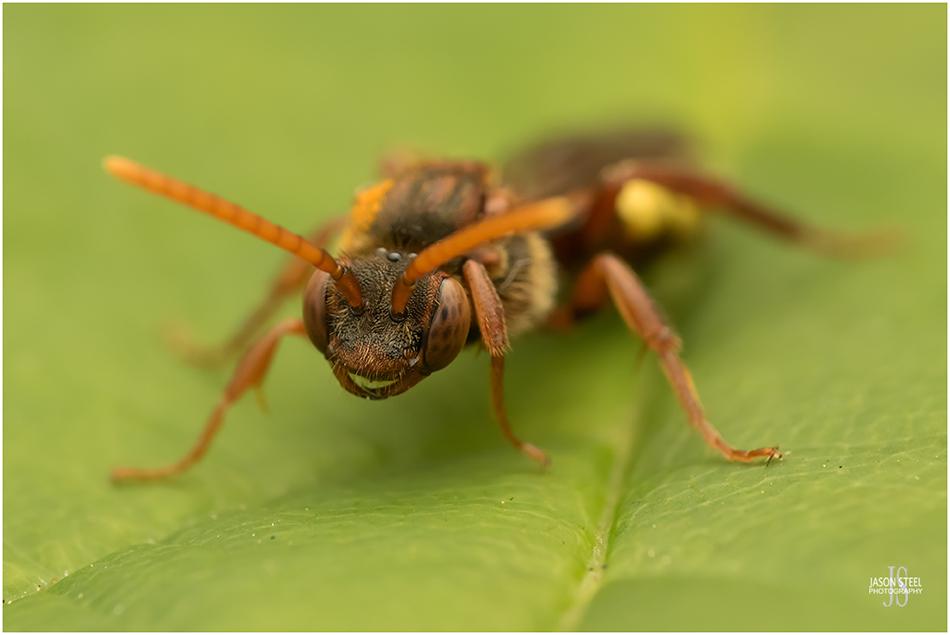
Nomad Bee from the Nomada flava group, photographed at Biggs Hill Wood, Bexleyheath, 15th May 2023.

Nomad Bee from the Nomada flava group, photographed at Biggs Hill Wood, Bexleyheath, 15th May 2023.
The conditions were quite windy when I photographed this bee and the plants were getting blown all over the place. It was only when I zoomed in on the image that I noticed the bee was clinging on to the plant with its jaws.
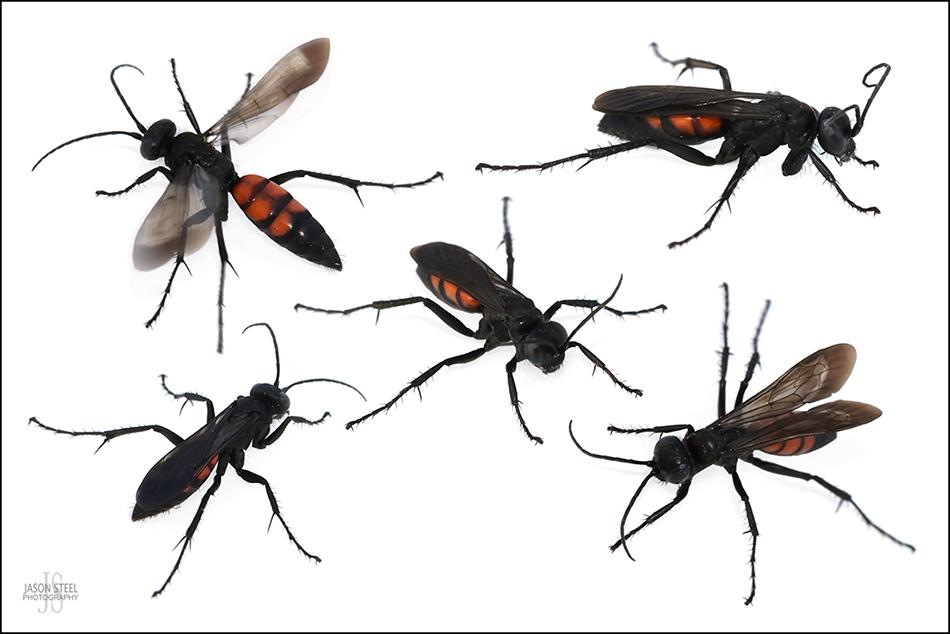
12mm Black-banded Spider-Hunting Wasp found hunting on sandy soil at Surrey Heathland, March 2022
Black-banded Spider-Hunting Wasp (Anoplius viaticus)
Growing to around 14mm in length Anoplius viaticus is one of the larger species from the Pompilidae family of Spider-Hunting Wasps. There are around 44 different species of Spider-Hunting Wasp in the UK, with two of these found only on the Channel Islands.
Adult Black-banded Spider-Hunting Wasps feed on nectar, sourced from flowers, but they prey upon spiders as hosts for their parasitic larvae. This species is commonly associated with heathland sites and dunes, where sandy soil is present. Adult females overwinter and emerge around March. Anoplius viaticus are one of the first Pompilidae species to be seen in the new year. The only other Pompilidae species that hibernate as adults and emerge in March are Priocnemis coriacea, Priocnemis perturbator and Priocnemis susterai. Along with their large size and striking colouration this makes Anoplius viaticus one of the easiest Pompilidae species to identify at this time of year.
On sunny days these long-legged wasps can be seen skipping over bare, sandy soil, with short bursts of flight, as they hunt for small spiders, primarily Wolf Spiders from the Lycosidae family. Once a spider has been caught it's quickly injected with venom and completely paralysed. Once paralysed the spider is usually secured to low vegetation whilst the Spider-Hunting Wasp begins digging her burrow. During this time other predators can sometimes try and steal the prey, and it's not unusual for fights between Spider-Hunting Wasps to ensue over captured prey. Once the female has dug her burrow, and safely concealed the paralysed spider at the bottom of her burrow, she will lay her eggs in the spider and seal the burrow. She will often keep guard over the burrow to ensure her catch isn't dug up and stolen by another predator. Once the eggs hatch the larvae of the wasp will feed on the spider.
Overwintered adult females that emerge in March will die off around June or July, but they are immediately replaced by the next generation that can be seen until they hibernate around September in deep burrows. Adult males are usually only seen from June until September before dying off. Adult males do not overwinter.
Spider-Hunting Wasps have a very powerful sting capable of causing instant, and long-lasting, paralysis of other invertebrates. This sting is also reported to be extremely painful to humans as well. American scientist, Justin O Schmidt, produced his own pain scale for insect stings, and the sting of larger species of Spider-Hunting Wasps were rated at the highest level of 4/4 for pain on his scale. The smaller species were still rated very high at 3/4, when compared to the average sting of a bee, which was rated at 2/4.
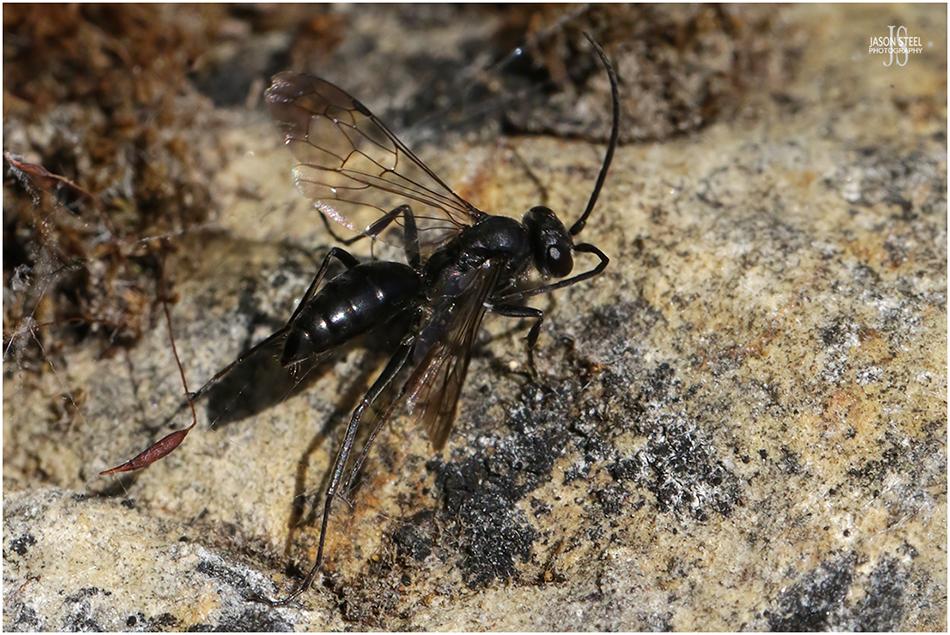
Potter Spider-Wasp, Auplopus carbonarius
Potter Spider-Wasp (Auplopus carbonarius)
Auplopus carbonarius is another Spider-Wasp from the Pompilidae family. The Potter Spider-Wasp is largely a southern species in the UK and is generally considered as scarce. It is often associated with woodland, especially in damp areas. Females grow to around 10mm and the similar males reach around 8.5mm. The female hast rather unique nesting behaviour. It constructs a nest, from mud and clay, usually consisting of around 10 barrel-shaped holes. Once the female catches the spiders the legs are quickly amputated. The spider is then carried, or dragged, back to the nest and deposited in one of the 10 holes where the larvae will develop inside the spider. Adult wasps fly from May to September. Auplopus carbonarius preys on a wide variety of spider species.
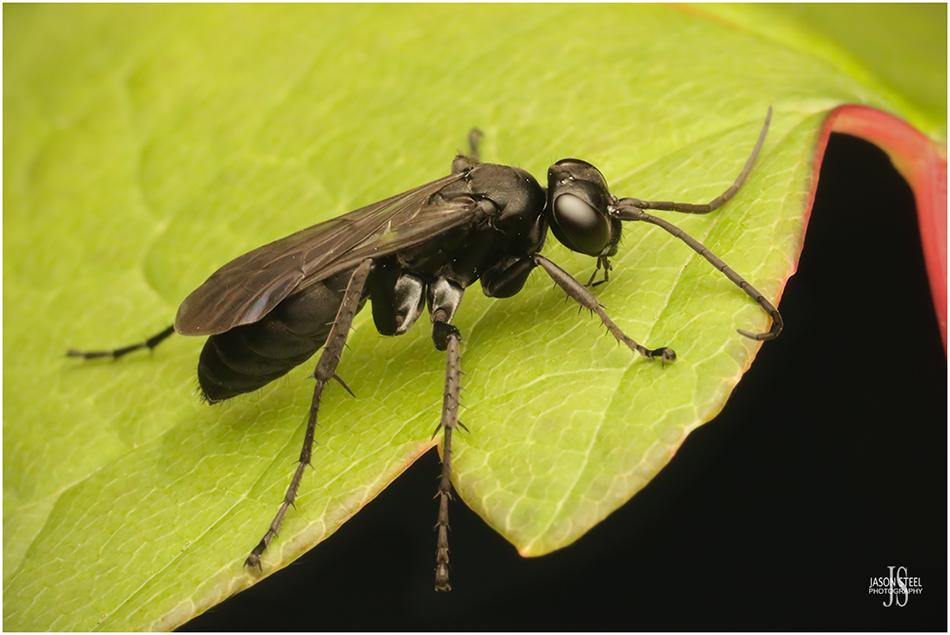
9mm female Common Black Spider-Wasp, Anoplius nigerrimus, found in a park in north Kent, 3rd October 2023.
Common Black Spider-Wasp - (Anoplius nigerrimus)
Anoplius nigerrimus is the most common of the three Anoplius species found in the UK. The Common Black Spider-Wasp is regularly found in habitats with sparsely vegetated soil, particularly clay. Farmland, brownfield sites, dry grassland and woodland clearings are the most regularly used. It is less commonly encountered on sandy soil. Other members of the Anoplius subgenus are commonly associated with wet soils. Both males and females usually grow up to a length of 8mm but females can reach 10 or even 11mm. The Common Black Spider-Wasp typicaly flies from May to the end of September. "The triangular or petiolate third submarginal cell allows separation from A. concinnus and A. caviventris." - LINK
Like other Pompilidae Anoplius nigerrimus has a very powerful sting that is used both to permanently paralyze its prey and to deter potential threats. Whilst photographing this Common Black Spider-Wasp I made the mistake of catching it in my bare hand when it tried to fly off. Wow! What an incredibly powerful sting. The result was an instant and incredibly sharp pain, comparable to an electric shock, that disappeared after about 10-20 seconds.
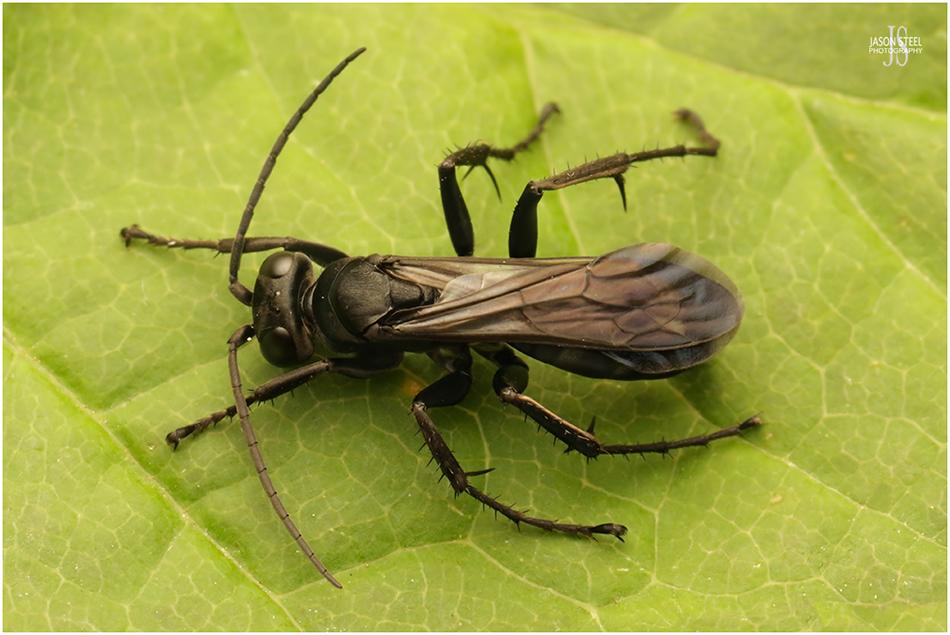
9mm female Common Black Spider-Wasp, Anoplius nigerrimus, found in a park in north Kent, 3rd October 2023.
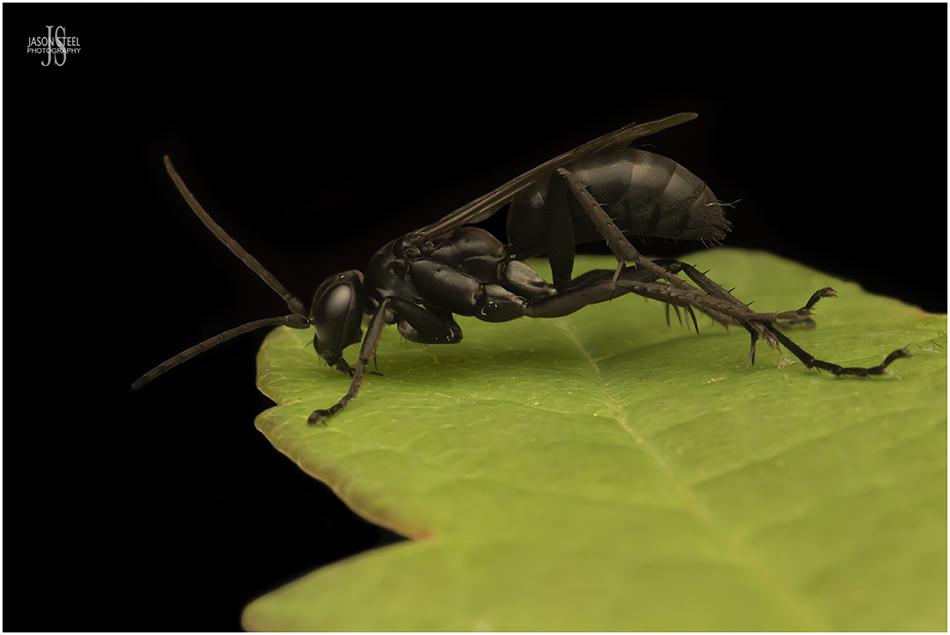
9mm female Common Black Spider-Wasp, Anoplius nigerrimus, found in a park in north Kent, 3rd October 2023.
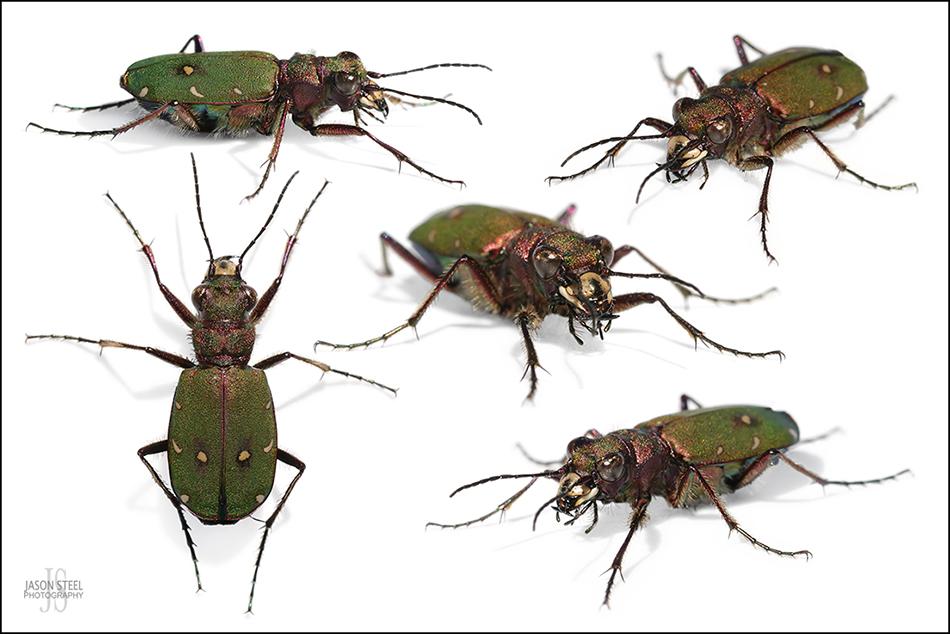
13mm Green Tiger Beetle hunting on sandy soil on the banks of a dried woodland pond in Surrey, 15th April 2022
Green Tiger Beetle (Cicindela campestris)
These sun-loving, predatory beetles are usually found on heathland and moorland across all of the UK. They are the most widespread and common Tiger Beetle species in the Britain. Green Tiger Beetles are most often seen when they're hunting on bare, open, sandy or chalky, soil for any invertebrates they encounter. Adult specimens are commonly found from May to July, but sometimes as early as April, or as late as October. This is a medium sized beetle typically growing from 12-15mm. They vary in shade from a dark and dull green to a light and bright green, but all have a strongly metallic and iridescent finish. The wing cases have cream spots.
Green Tiger Beetles are competent fliers and will also take prey on the wing, as well as on the ground. They usually fly in short bursts, often make a buzzing sound as they fly. It is their speed and agility across land, their large eyes, and large mandibles that makes them such formidable hunters though, running at speeds of up to 60cm per second. The larvae dig burrows up to 30cm deep and take 2 years to develop before pupating at the bottom of their burrow.

13mm Green Tiger Beetle
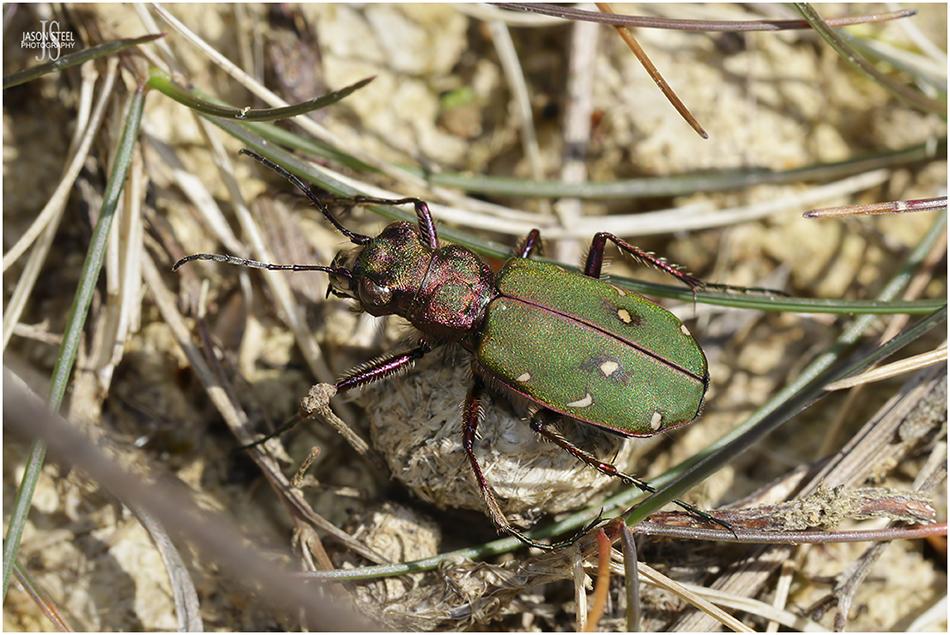
13mm Green Tiger Beetle hunting on sandy soil on the banks of a dried woodland pond in Surrey, 15th April 2022
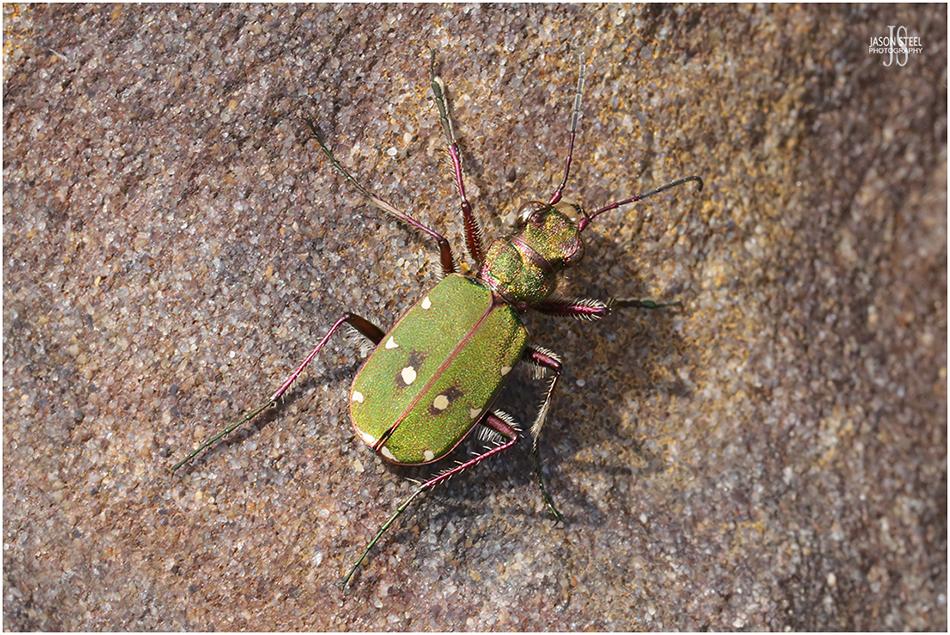
10mm Green Tiger Beetle, Surrey heathland, 9th April 2023
One of four Green Tiger Beetles found at Crooksbury Common, in Surrey. They were all fairly small specimens at 10-12mm in length, and were seen hunting on sandy paths and around the pond edges.
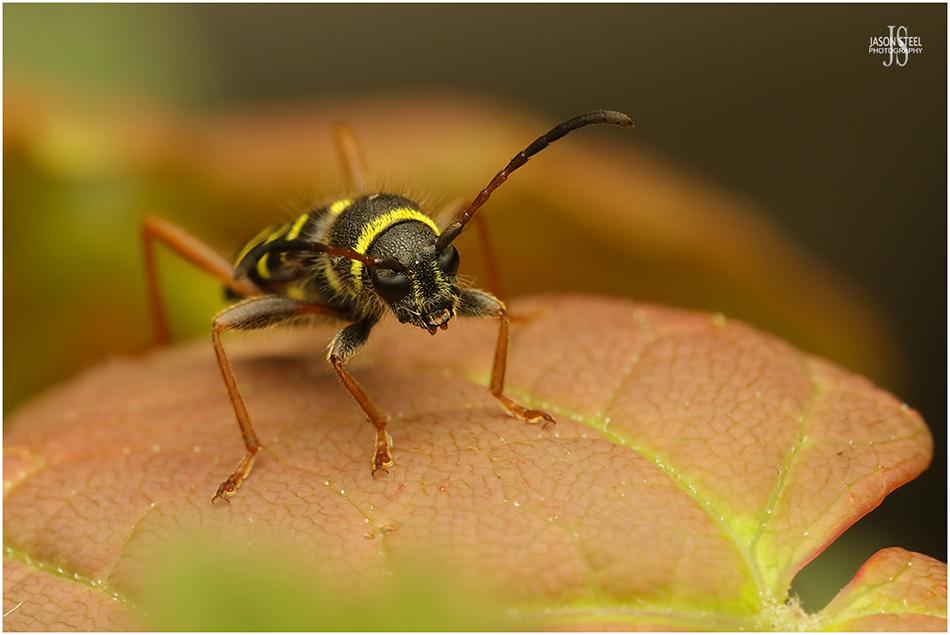
Wasp Beetle, Clytus arietis, found in low branches of deciduous trees at Ashdown Forest, 20th May 2022.
Wasp Beetle - Clytus arietis
With its striking black and yellow colouration this harmless and widespread beetle is a great mimic of a wasp. This is a distinctive species that can often be seen resting on low vegetation at woodland edges, gardens and parks. Wasp beetles breed on the rotting wood of deciduous trees, such as willow and birch, where the small, white and grub-like larvae will feed. Adults feed on primarily on pollen from a variety of flowers, but will occasionally feed on small invertebrates too. Adult beetles grow to around 9-13mm and emerge in May, After a few months of adult life they die towards the end of the summer. The only species of beetle that the Wasp Beetle might be confused with is the larger Plagionotus arcuatus. However Plagionotus arcuatus can be distinguished by their entirely pale orange antennae, when compared with the black and orange antennae of the Wasp Beetle. These colourful beetles feature on the NHM's list of Britain's Most Spectacular Beetles.
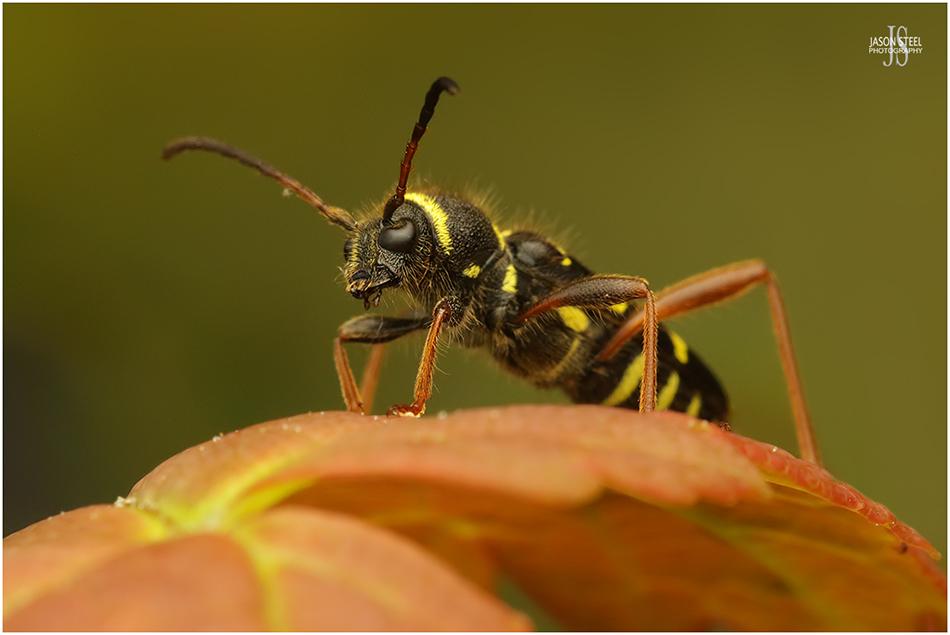
Wasp Beetle, Clytus arietis, found in low branches of deciduous trees at Ashdown Forest, 20th May 2022.
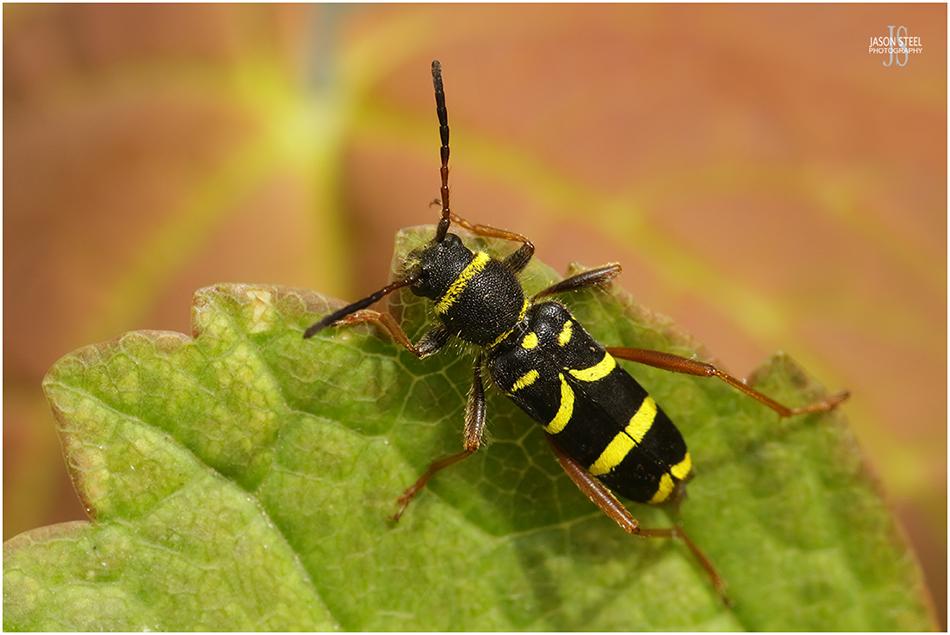
Wasp Beetle, Clytus arietis, found in low branches of deciduous trees at Ashdown Forest, 20th May 2022.

Wasp Beetle, Clytus arietis, found in low branches of deciduous trees at Ashdown Forest, 20th May 2022.
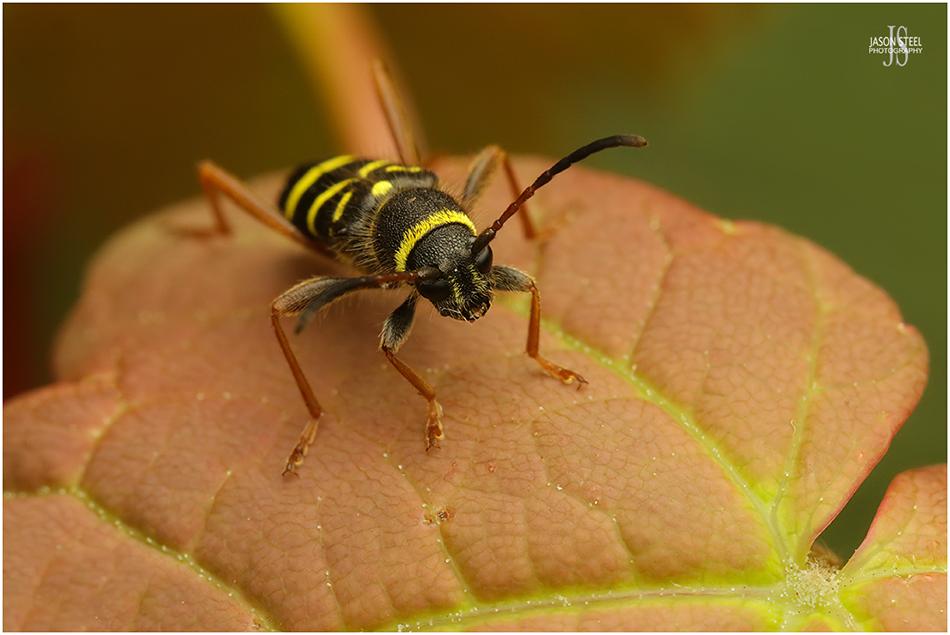
Wasp Beetle, Clytus arietis, found in low branches of deciduous trees at Ashdown Forest, 20th May 2022.
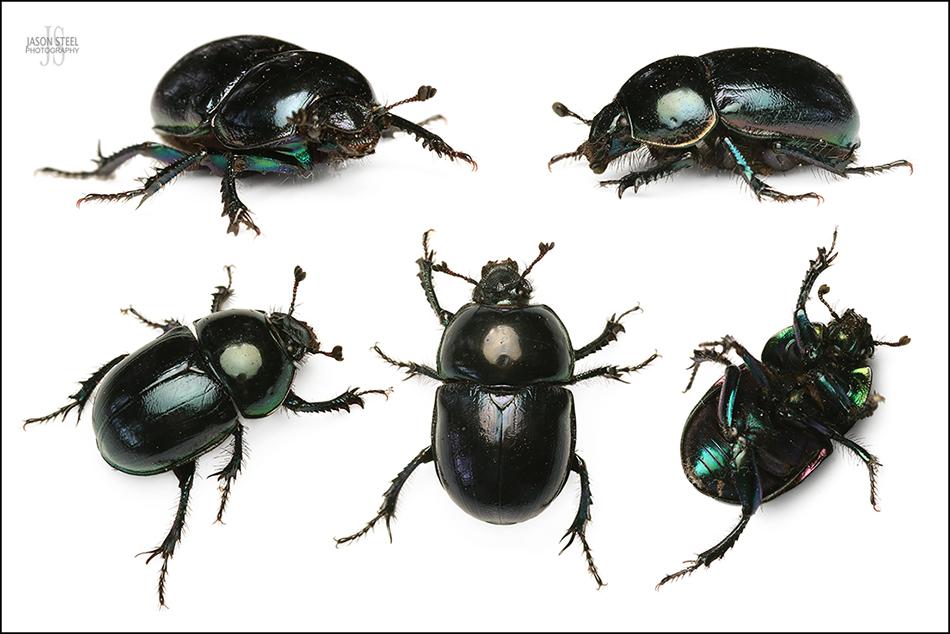
One of 8 specimens of Dor Beetle, found wandering on the sandy soil of Surrey heathland, 1st October.
Dor Beetle - (Geotrupidae)
In the UK there are 8 species in the Geotrupidae family of Dor Beetles, which are divided into five Genera. These are Anoplotrupes, Geotrupes, Odonteus, Trypocopris and Typhaeus.
One species, the Minotaur Beetle, Typhaeus typhoeus, is unmistakeable. However, the other species of Dor Beetle are not as easy to tell apart. All Geotrupidae species excavate vertical burrows in which the female lays her eggs. For this reason they are often referred to as Earth Boring Dung Beetles. Dor Beetles are strong fliers and usually fly at night. They are attracted to light, making them a regular find in some moth traps. Dor Beetles usually dig their burrows 5-60cm deep and very close to sources of dung. Minotaur Beetles are the exception and can dig their deep burrows 100-150cm deep. Minotaur Beetles are also our only species of dung-rolling beetle in the UK.
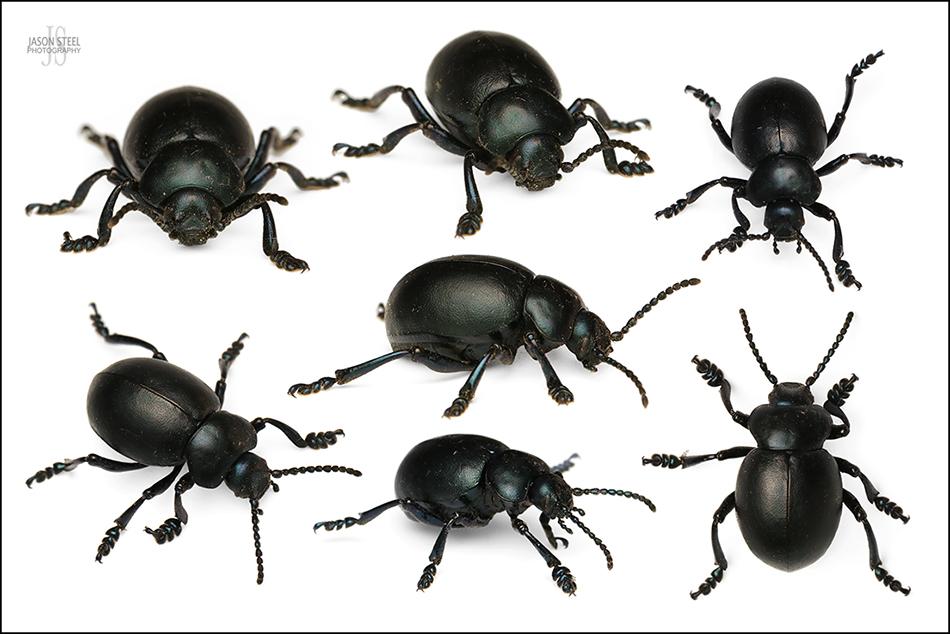
Bloody-nosed Beetle, found wandering on the sandy paths of Tintagel, North Cornwall, 9th August 2022.
Bloody-nosed Beetle - (Timarcha tenebricosa)
The Bloody-nosed Beetle is considered to be common and is one of our largest species of Leaf Beetle in the UK. Although at first glance these beetles look completely black they actually have a blue metallic sheen in sunlight. Adults can reach a body-length of around 13-23mm, and are typically seen in early summer on low vegetation or plodding slowly across the ground of grassland, heathland and hedgerows, especially in southern coastal areas. It's not uncommon for them to be seen crossing public footpaths where they are frequently trodden on. The Bloody-nosed Beetle gets its name due to a defensive behaviour it exhibits if captured by a predator or handled roughly. The beetle is able to rupture thin membranes in its mouth and force out a bright red haemolymph fluid. This fluid is completely harmless to humans but it does have a pungent smell, and a very bitter and foul taste, which is often sufficient to deter predators. The elytra (wing cases) are fused together and the Bloody-nosed Beetle is a flightless species. The larvae appear around April and take 5-8 weeks to fully grow before heading to the ground to pupate in June. The adults emerge 3-4 weeks later and can live for around 15 months, so can be found throughout most of the year. April to September are when adults are usually seen active. The larval food source are Cleavers (Goosegrass) and Bedstraws, especially Ladies Bedstraw.
In the UK we also have the smaller Lesser Bloody-nosed Beetle, Timarcha goettingensis, which reaches 8-13mm. This species can be distinguished from its larger cousin by the shape of the legs and body and by its colouration. The Lesser Bloody-nosed Beetle is also a black beetle but tends to have a violet or coppery sheen. LINK
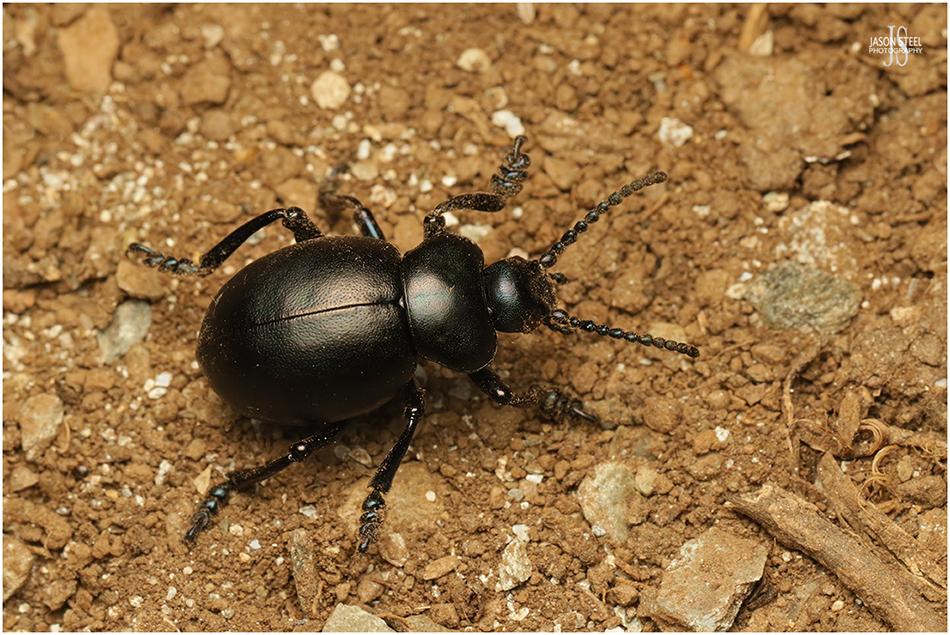
Bloody-nosed Beetle, found wandering on the sandy paths of Tintagel, North Cornwall, 9th August 2022.
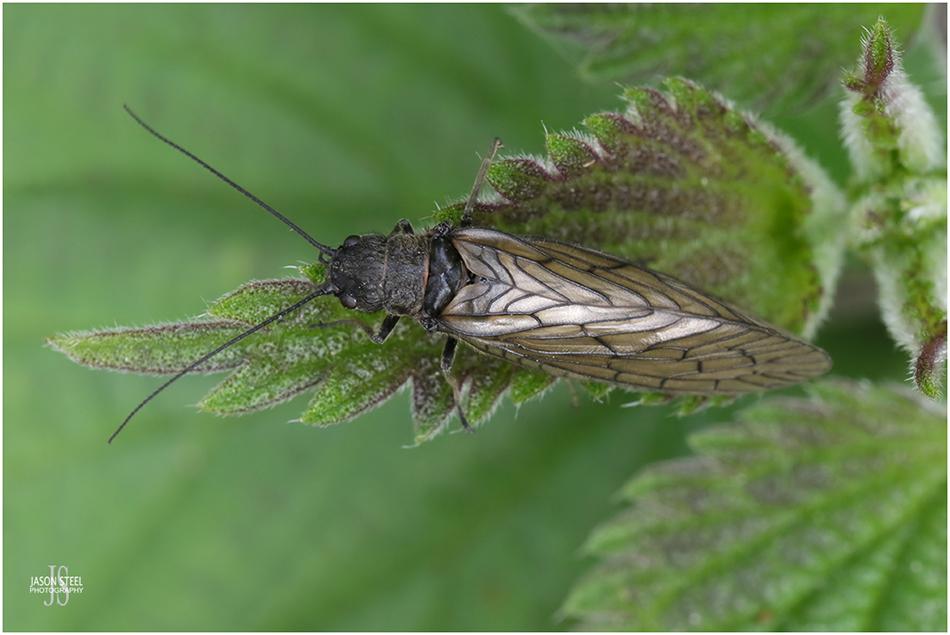
Alderfly on low, riverside vegetation, at Canterbury, Kent, 2nd May 2022
Alderfly - (Sialis sp.)
The Alderfly is a large and slow moving insect that's usually seen on vegetation overhanging ponds and slow moving rivers and streams. Alderflies belong to the Megaloptera order of insects, which contains the alderflies, dobsonflies and fishflies. In the UK we have three very similar species of Alder Fly from the Sialis genus. All three are very difficult to tell apart and require microscopic examination of the genitalia, or anal plates, to identify to species level. Alderflies are dark brown in colour, with greyish-brown wings with black veins .The most common species is the UK is the Mud Alder Fly, Sialis lutaria, and this is the most likely species to be found in garden ponds. Adult Alder Flies typically have a body-length of 10-15mm. Alderflies are completely harmless to humans and are incapable of inflicting a bite.
Alderflies live as an aquatic larvae in the silt at the bottom of ponds and slow moving fresh water, usually for 1-2 years. Some may take 3 or more years before fully developing, depending on temperature and availability of prey. The Alderfly larvae is a predator of small aquatic invertebrates. Once fully grown the larvae pupate near the water's edge, and emerge as adults a few weeks later. It is common for large numbers of Alderflies to emerge at the same time from late April until June. Adult Alderflies usually live for just a few days, but some may last for 2-3 weeks. Once emerged the adults waste no time and immediately seek out a mating partner. Mating usually occurs on low vegetation near the water. Eggs are then laid in large masses, sometimes as many as 3000 eggs, on vegetation that overhangs the water, or on rocks that protrude from the water's surface. It takes just 1-2 weeks for the eggs to hatch. Once hatched the tiny larvae drop into the water below. Many of these Alderfly larvae will be eaten by fish, and other aquatic predators. A photo of the larvae can be seen on this page: Pond Life
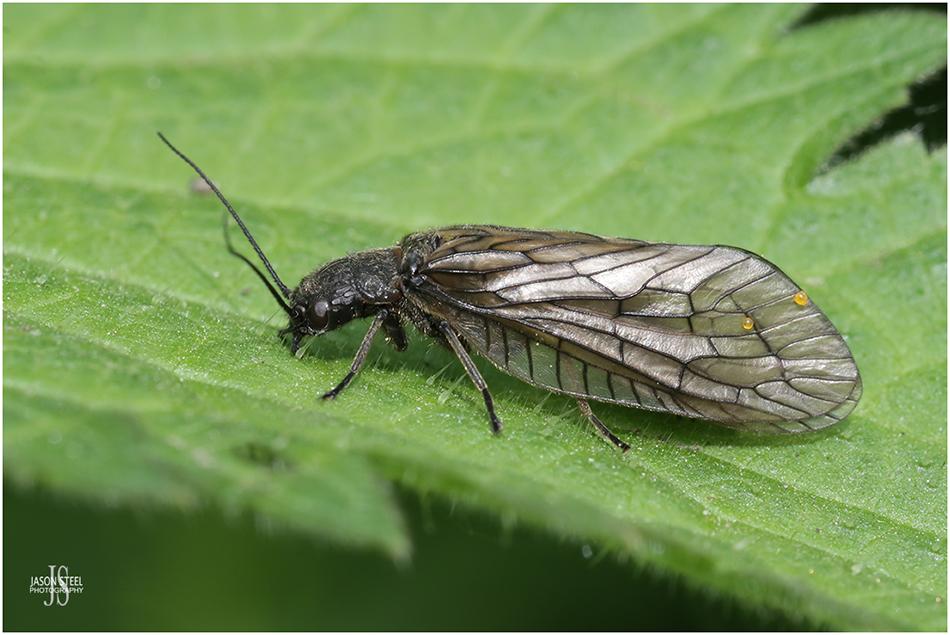
Alder Fly on low, riverside vegetation, at Canterbury, Kent, 2nd May 2022
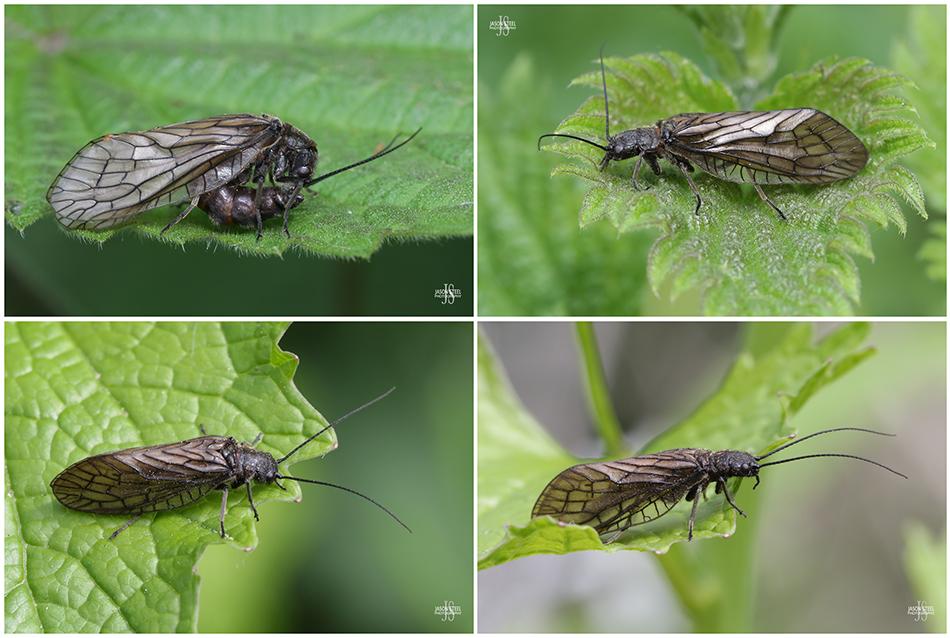
Alder Fly on low, riverside vegetation, at Canterbury, Kent, 2nd May 2022
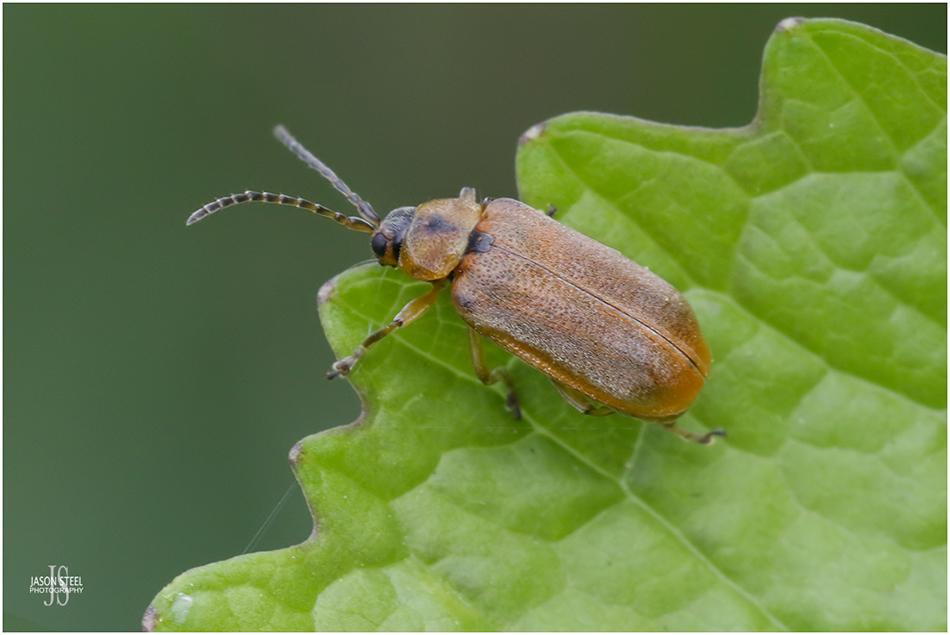
Viburnum Leaf Beetle on low, riverside vegetation, at Canterbury, Kent, 2nd May 2022
Viburnum Leaf Beetle - (Pyrrhalta viburni)
The Viburnum Leaf Beetle is a small golden-brown beetle that grows to around 5mm in length. Both the adults and the creamy-white larvae feed on the leaves on Viburnum plants, including Guelder Rose, the Wayfaring Tree and various garden varieties too. In 2010 the RHS reported this species as the number one garden pest of that year. Adult females chew cavities in the stems of Viburnum plants, in which to lay their eggs. The larvae of Pyrrhalta viburni typically emerge in May. Adults are most commonly seen in June and July.
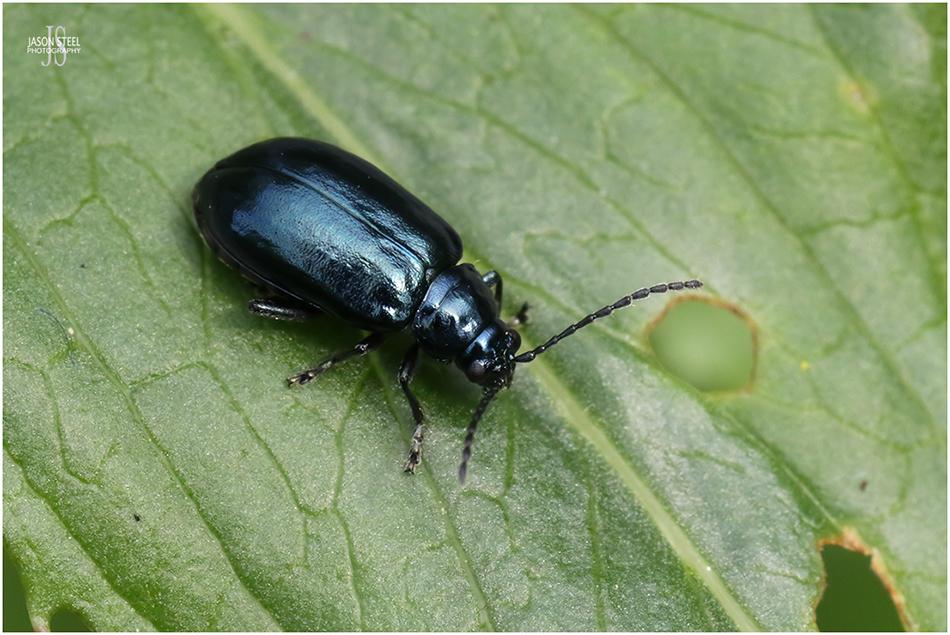
Alder Leaf Beetle, Agelastica alni, on low, riverside vegetation, under overhanging trees, at Canterbury, Kent, 2nd May 2022
Alder Leaf Beetle - (Agelastica alni)
The Alder Leaf Beetle is a small dark beetle with a deep metallic blue, or sometimes violet, sheen. This beetle grows to around 5-7.5mm in length. Although once considered to be extinct in the UK the Alder Leaf Beetle is now once again common and widespread in parts of England. Adult beetles are typically seen from spring right through to autumn. Both the adults and larvae feed mainly on the leaves of Alder trees(Alnus), but will also sometimes feed on the leaves of other deciduous trees such as Beech (Fagus sylvatica), Hazel (Corylus), Hornbeam (Carpinus betulus), Downy Birch (Betula pubescens) and Goat Willow (Salix caprea) too. The adult beetles overwinter in soil and leaf litter near the host trees and emerge around April. The yellow / orange eggs are laid on the leaves of the host trees. After 10-12 days the larvae emerge, with yellow bodies and black heads. As they feed they turn pale grey in colour. They are fully developed in around 25-30 days. By this stage the larvae are completely black, and they drop to the ground to pupate just beneath the soil, or in leaf litter. The new generation of beetles emerge as adults after about 3 weeks, from July until September.
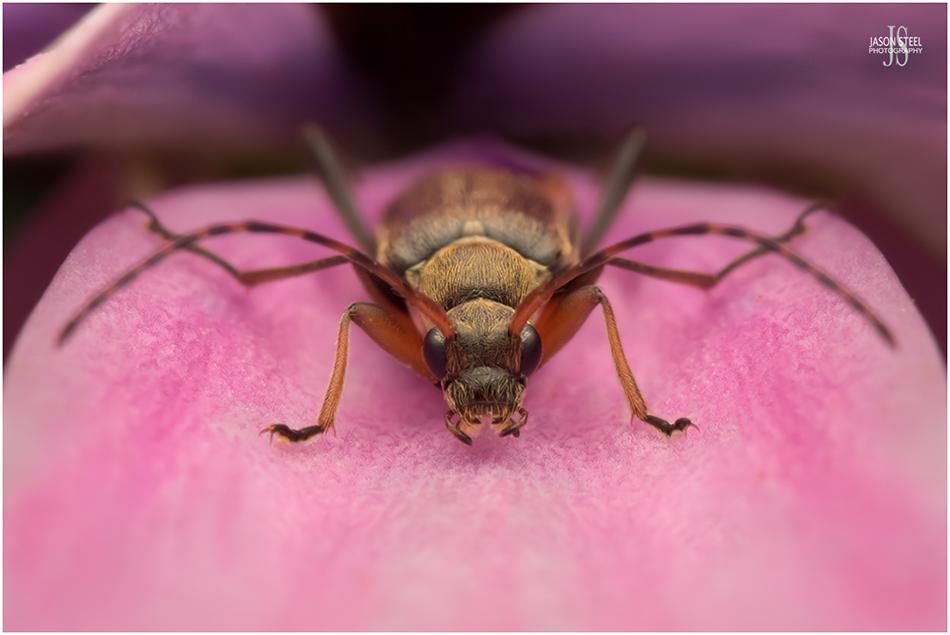
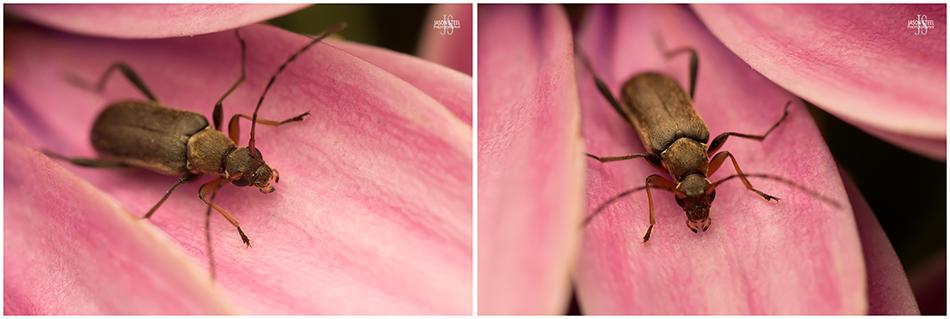
Common Grammoptera (Grammoptera ruficornis) found on flowers beneath trees in Biggs Hill Wood, SE London. 15th May 2023
Common Grammoptera - (Grammoptera ruficornis)
Grammoptera ruficornis is from the Cerambycidae family of Longhorn Beetles, and is probably the most common species of Longhorn Beetle in the UK. These small beetles usually have a body-length of just 3-7mm, but occasionally they may reach up to 10mm. The females are both longer and wider than the males. Grammoptera ruficornis is commonly found around wooded parks and open deciduous forests. Adult beetles can be found feeding on pollen and nectar from a variety of flowers, including Hawthorn and Cow Parsley. The larvae feed within dying branches of deciduous trees, usually those infested with fungus. The larvae feed throughout the summer and hide beneath loose bark through the winter. When fully developed the larvae pupate in early spring and adults can emerge from April and May.
There are two other Grammoptera species in the UK, and both are considered to be rare. Grammoptera abdominalis is larger and lacks the long 2nd segment found on the antennae of Grammoptera ruficornis. The antennae of Grammoptera ruficornis are orange with black rings, but the antennae of Grammoptera abdominalis are uniformly dark. The other species, Grammoptera ustulata can be similar in appearance, but is typically more golden in colour due to the pale hairs found on its elytra.
The Grammoptera ruficornis specimen pictured above was quite unusual because it exhibited the golden pubescence more typically found on Grammoptera ustulata.
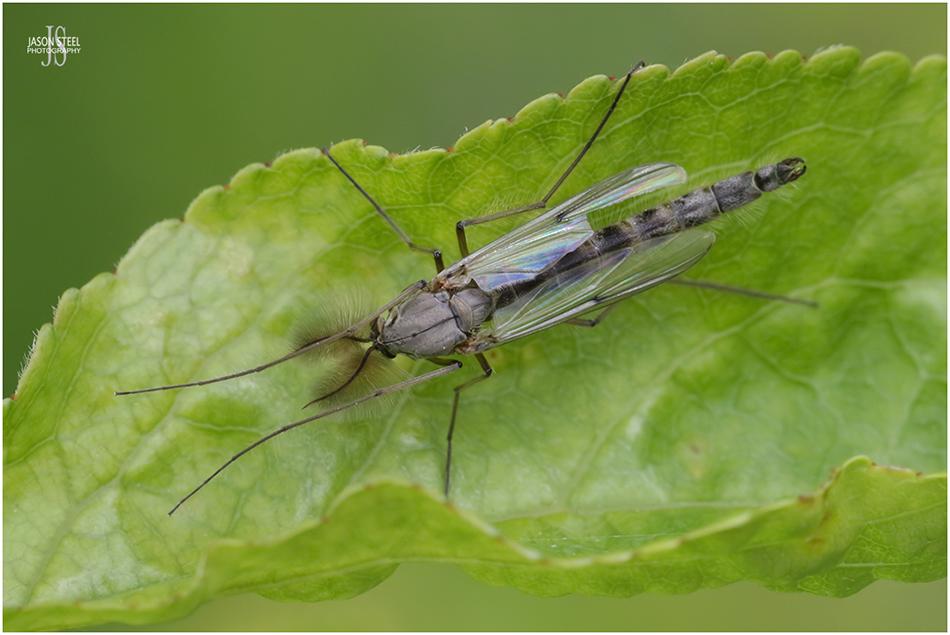
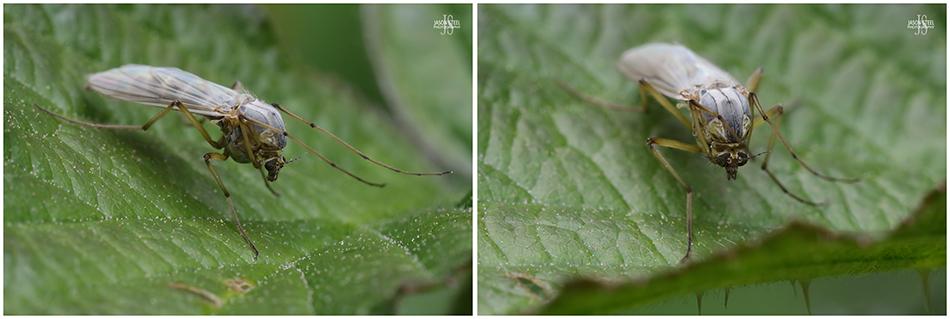
12mm Buzzer Midges, Chironomus cf plumosus. Found on riparian vegetation in Lullingstone, Kent, 27th April 2023. Male top. Female below.
Buzzer Midge / Non-Biting Midge - (Chironomus plumosus)
There are over 500 species of Non-Biting Midge in the UK alone, and around 150 species of Biting Midge. Non-Biting Midges belong to the Chironomidae family, and are often known as Blind Midges. Biting Midges are from the Ceratopogonidae family. Whilst they look very similar to Non-Biting Midges they do not feed on blood. Only the females of Biting Midges are parasitic, and feed on blood for the development of their eggs. Mosquitos are also similar in appearance to Midges. Mosquitos form the Culicidae family, and there are around 30 known species of Mosquito found in the UK.
So how do you tell harmless Midges apart from Biting Midges and from Mosquitoes? Non-Biting Midges usually have wings that are shorter than their body. The wings of Mosquitos are usually the same length, or longer that their body. Biting Midges and Mosquitos also have a long needle-like projection from their mouth, known as the proboscis, that they use to pierce the skin of their host and feed through. Non-Biting Midges only live long enough to mate and produce eggs, usually less than 48 hours. Some species of Biting Midge and Mosquito can live for months. Biting Midges and Mosquitos have far shorter front legs that Non-Biting Midges. Biting Midges are usually only 3-4mm in length.
At 12mm in body-length Chironomus plumosus is the largest of the Non-Biting Midge species in the UK. Males can be identified by their large plumages at the front of their head. Chironomus plumosus is sometimes referred to as the Buzzer Midge. Another common name for Chironomus plumosus is the Lake Midge. This Midge, like most other species of Midge, is highly variable in colour, and accurate identification can only be done my microscopic examination. At 12mm in size though these images are fairly likely to be of the male and female Chironomus plumosus, although both C. muratensis and C. nudiventris look identical. Adult Chironomus plumosus can be found from February until October, but this species peaks in April.
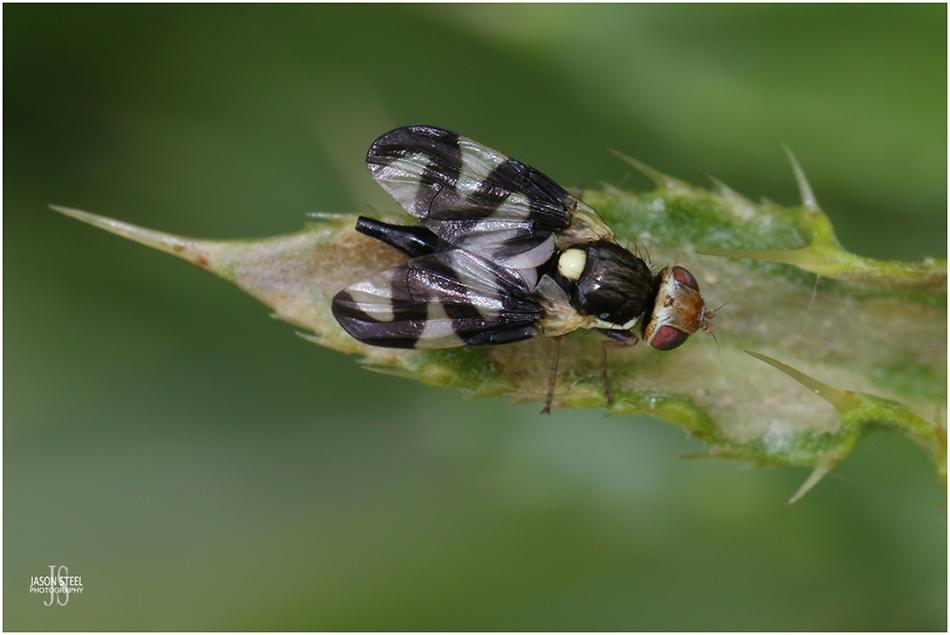
6mm female Thistle Gall Fly, found in Cliffe, Rochester, Kent. 30th June 2023.
Thistle Gall Fly / Canada Thistle Gall Fly - (Urophora cardui)
The Thistle Gall Fly is one of several similar species from the Tephritidae family of Fruit-flies. These small, but striking flies grow to a body-length of around 6-8mm. The female lays her eggs on the stems of Creeping Thistles / Canada Thistles, Cirsium arvense. Once hatched the burrow into the stems of the thistles where they form the characteristic galls, in which they develop. When fully developed the larvae pupate within the galls and emerge at the start of summer. The Thistle Gall Fly is confined mainly to the south and east of the country, but can be locally common. These flies are native to central and southern Europe, but were also introduced to North America and Canada to reduce the spread of thistles.